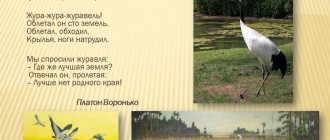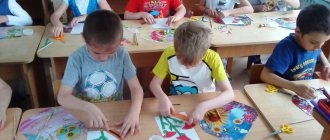Contents of the travel game
1 station "Poetic"
Children compose quatrains based on the suggested rhymes. Rhymes are given as final rhymes and can be interchanged.
Examples of rhymes:
Cannon May Salyut Rad Hero
Ushko Congratulate My Parade Here
Victory Bouquets Shooting Beauty Soldiers
Father of Victory Congratulations Purity Awards
2 station "Pesennaya"
Children sing war songs they know.
3 station "Pozdravatelnaya"
Children make a greeting card using the proposed decorative elements: pre-prepared flowers, bows and other types of decoration.
4 station "Istoricheskaya"
Children answer questions on the topic of Victory Day.
Examples of questions:
— When is Victory Day celebrated in our country?
— Name the years when the Great Patriotic War took place.
- Name the names of the heroes of the Great Patriotic War that you know.
— Name the monuments dedicated to the Great Patriotic War that are in our city.
— Name the streets in our city that are named in honor of the heroes of the Great Patriotic War.
5 station "Mysterious"
Children guess riddles on the theme of the travel game.
Examples of riddles:
This boat is not simple, but huge! Protects our peace, Swims only under water. (Submarine)
Like a festive bouquet, the light lit up in the sky! There are a lot of bright flashes here! This is a festive... (fireworks)!
This line cannot be crossed, friends. It is strictly guarded and enemies are not allowed through! (Border).
Flies past the clouds, He is huge and powerful. Our military... (plane) is taking its flight!
He will catch the intruder and recognize him by the smell. Serves in the army without fear Borderline... (dog)!
Jumping out of the plane, they took flight in the blue, summer, clear sky. Who are they? (Skydivers)
We go to the parade in the morning, We shout to Grandfather: “Hurray!”, We congratulate him on the holiday, We wish him happiness, In the evening we wait for the fireworks and go to watch it, And the grandfathers sing us songs. This holiday is... (Victory Day)!
6 station "Artisticheskaya"
Assignment: depict some object or concept on the theme of the army, Victory Day.
The names can be written on cards, which can be placed in a soldier's cap, from where their teams take them out. Examples of objects and concepts: fireworks, cannon, soldier, border dog, Victory Day, attack, reconnaissance, and so on.
7 station "Bystraya"
Task "Border"
In 30 seconds, the team must lay out a “border” line from cubes. The number of cubes is recorded on the route sheet. The team whose line is longest wins.
The second option for assessing the completed task: each team is given the same number of cubes. The presenter at the station records with a stopwatch how much time it takes the team to lay out the “border” line. The total time for completing the task is entered in the route sheet. The team that lays out the line faster than the rest wins.
At the end of the journey game, everyone gathers again to sum up the results and close the game. All teams can be awarded in different categories: the most friendly team, the fastest, the most poetic, the most musical, the most knowledgeable, the most dexterous, and so on. The main thing is that children have a desire to take part in such a game again.
The material was prepared by Natalya PRISHCHEPENOK, methodologist of the Moscow Regional Educational Institution of Children and Youth Children's Education Center "TsRTYU of the city of Kirov."
The following thematic excursions can be conducted:
- “They are named after them” - about the history of the streets that were named in honor of the heroes of the Great Patriotic War;
- “Immortal Feat” - about monuments dedicated to the Great Patriotic War in your city or village;
- excursion to the Eternal Flame monument;
- “Place of Feat” is about significant places in the city, village, town, village and surrounding area. Such an excursion is most relevant for those places where battles took place during the Great Patriotic War, but it can also be carried out at the places where divisions were formed and near those buildings where hospitals and military enterprises were located during the war, that is, where people performed feats in the rear ;
- a series of excursions “City of Labor Glory” - to the enterprises that worked in the rear during the war.
The duration of the excursion dedicated to the holiday of May 9 for preschool children should not exceed 40-45 minutes. These excursions can be conducted throughout the year, devoting them to significant dates of the Great Patriotic War.
Very often, such classes are offered by Children's Art Centers, where you can take children to a themed activity.
In the process of preparing for the May 9 holiday in kindergarten, there is an opportunity to clarify and expand children’s knowledge about military equipment and people in military professions. To do this, you can use toys depicting military equipment, demonstration materials, a computer presentation, if conditions permit, or an excursion to a monument - military equipment. Children examine the monument and listen to the teacher’s story about it.
Travel game “Victory awaits us!”
The point of the travel game is to complete various tasks as a team, which are assigned at various so-called stations. This form of work can have different names: a relay game, a station game, or even a quest game. The meaning remains the same: performing various tasks.
The criteria for winning may also be different:
- The team that goes around all the stations first can win;
- the team that will receive the most points for tasks completed at stations;
- a team that will bypass as many proposed stations as possible in a certain time.
The nature of travel games can also be different. A travel game can be dedicated to testing knowledge on any topic; At the stations, children can find out some information, for example, as in our case, regarding the May 9 holiday.
The system for passing stations may also be different. Teams may have a route sheet showing station locations. In this case, you can visit any currently free stations. The location and order of stations may be indicated. In this case, the possibility of accumulation of a large number of commands simultaneously at one station will be excluded. The route sheet may indicate the names of the stations, but does not say where they are. This is possible, for example, if all stations are located in the same room, for example, in an assembly hall. A route sheet is also needed to mark the stations passed or the points received at them for completing tasks.
For children 6-7 years old, for whom a travel game can be played on the May 9 holiday in kindergarten, it is better to indicate the order of passing the stations and their location. And, of course, in this case, an adult must go through the travel game with each group in order to eliminate various hiccups.
The number of people in a team can be from five to seven. The number of stations must either match the number of teams or be one more.
Any travel game necessarily begins with a line or collection of the opening of the game, where the theme of the game is told to the children and the rules are explained. Children are divided into teams, they are given route sheets, they are told where the travel game stations are and the game is given a start.
After this warm-up game, the relay competition begins.
Relay tasks
- Infantry
Competition “Step March!”
The first team member marches from the start line to the finish line, which is marked with a flag. You can move back in a free style, for example, by running. After the first participant has reached his team, he passes the baton to the next, and the second team member also marches to the flag and runs back. When the last team member reaches his team, everyone must raise their hands and say: “Ready!” The teams begin to march at the command of the leader, “Marching in steps!”
A more complicated version of the relay race, for more physically prepared children: the participants do not march in turns, but joining each other: the first, having returned, marches to the flag again, but is already joined by a second participant, then a third, and so on, that is, everyone marches in formation , two by two.
Competition "Swamp"
Hoops are laid out on the floor from the start line to the finish line. These are hummocks in a swamp. The teams' task is to run from start to finish, jumping through hoops. You can run back along the “swamp”. If on the way to the finish line someone stumbles and falls from a “bump” into a “swamp”, he must start the path over again.
Competition "Crossing"
Gymnastic benches are installed. This is a river crossing. The teams’ task is to make their way from start to finish along gymnastic benches. You can run back along the benches.
"Thrown March" competition
This is the so-called medley relay race. Each team member must overcome several stages: climb through a hoop, jump two meters on a skipping rope, crawl under a gymnastics stick. Everyone just runs back.
- Artillery
Competition "Hit the Target"
A “target” is placed on the finish line - a box or some other container, into which team members from a certain line take turns throwing “projectiles” - small balls. The team that throws the most “shells” wins.
- Intelligence service
Competition "Night Reconnaissance"
The teacher explains that scouts, when obtaining information or some materials, often act in the dark in order to remain invisible. One volunteer from the team is called up - a scout. He is given the task: blindfolded, to find out by touch what objects are in front of him. Items are laid out on a chair after the scout is blindfolded. These can be either traditional items for kindergarten, such as toys, or unusual ones that you usually won’t find in kindergarten.
Competition "Crawl and don't hit me"
Gymnastic mats are laid out on the floor. The participants’ task: take turns, one after another, to crawl along the mats under a gymnastic stick without catching it. An option is a stretched rope or rope to which bells are attached. You have to crawl so that they don’t ring.
- Flight troops
Competition "Flight Range"
Assignment for participants: stand on one line and launch airplanes. Teams must have airplanes of different colors so that they can determine which team member’s airplane will fly farthest.
The second version of the relay: if the children know origami and know how to make airplanes, you can give each one a sheet of A-4 paper for preliminary production of props for this stage of the relay.
- Navy
Competition “Tying Knots”
The task of the teams is to tie as many knots as possible on the ropes offered to them in a minute.
Competition option: everyone in the team is divided into first - second, each first knot ties, every second one unties. Everyone does this while standing in line. The winner is the team whose rope with a knot passes through the most people in one minute.
Competition "Tug of War"
Each team takes hold of its end of the rope, and at the command of the leader, a tug-of-war begins. The team that wins is the one that gets him to their side the fastest.
Competition "Sea voyage"
In basins filled with water, transport a paper boat from one shore to another as quickly as possible, blowing on it. Either one person or the whole team can blow.


